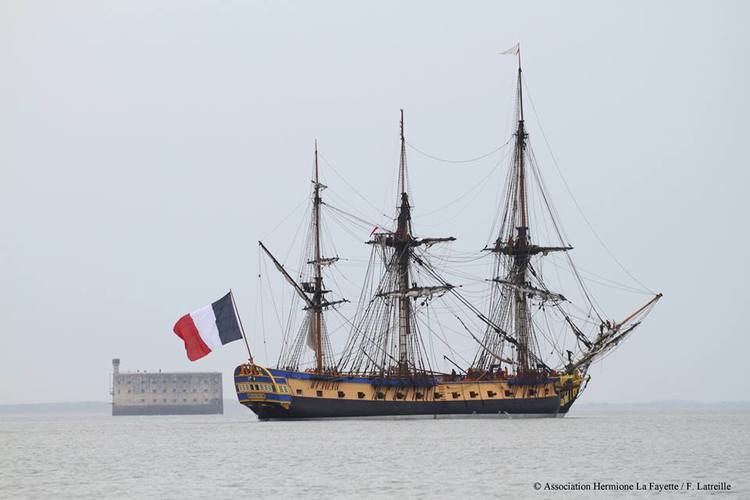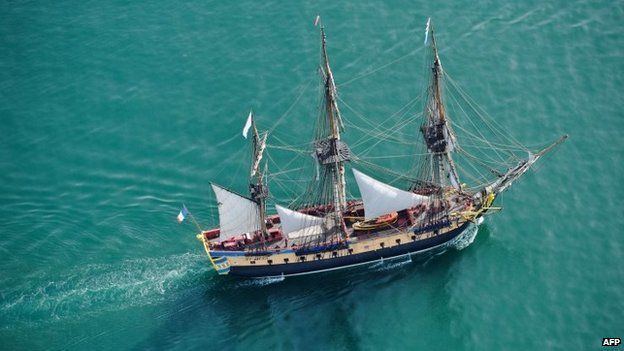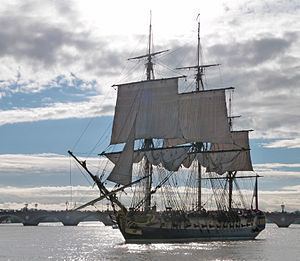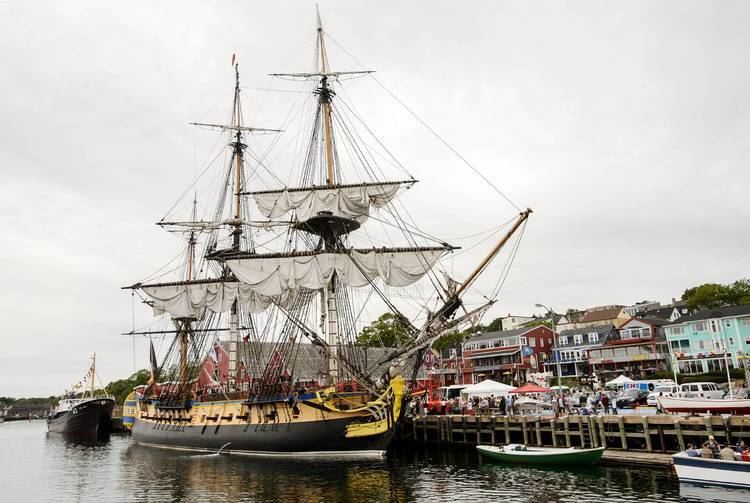Laid down March 1778 Construction started March 1778 Length 44 m Place built Rochefort, France Hull materials French oak, Wood | Builder Rochefort In service June 1779 Launched 28 April 1779 Weight 1,166 tons Designer Chevillard Aîné | |
 | ||
Fate Ran aground and wrecked due to a navigation error of her pilot at Le Croisic on 20 September 1793 Class and type Concorde class 12-pounder frigate | ||
The Hermione was a 12-pounder Concorde class frigate of the French Navy. She became famous when she ferried General Lafayette to the United States in 1780 for support to the Americans in the American Revolutionary War. She grounded and was wrecked in 1793.
Contents

In 1997, construction of a replica ship started in Rochefort, Charente-Maritime, France; the new ship is likewise named Hermione.
Career

Hermione was built in eleven months at Rochefort, by the shipwright Henri Chevillard as a light (French: légère) frigate, fast and maneuverable. Between May and December 1779 she underwent successful sea trials in the Gulf of Gascony under the command of Lieutenant de Latouche.

General La Fayette embarked at Rochefort on 11 March 1780 and arrived in Boston on 28 April carrying the secret news that he had secured French reinforcements (5,500 men and 5 frigates) for George Washington. After the dramatic failure of the Penobscot Expedition, a large military expedition to dislodge the British from their new stronghold at the confluence of the Bagaduce and the Penobscot River on the east bank of Penobscot Bay in Maine (an area later known as Castine), the revolutionary council of Massachusetts asked Latouche if he would be willing to sail to Penobscot Bay for a quick military intelligence-gathering cruise, checking on the strength of the British garrison at Fort George. The Hermione then made the week-long voyage in mid-May, after which the frigate sailed to Rhode Island. Next, she got underway again on 2 June and suffered serious damage in the fierce but indecisive Action of 7 June 1780 against the 32-gun HMS Iris, under James Hawker.
Hermione received the American Congress on board in May 1781. She fought several times in company with the Astrée, commanded by Lapérouse, especially at the Naval battle of Louisbourg on 21 July 1781.
After the end of the American Revolutionary War, Hermione returned to France in February 1782. She then formed part of a squadron sent to India to help Suffren against the British. However, peace was declared and the ship returned to Rochefort in April 1784.
Fate
Again in service against the British, on 20 September 1793, she ran aground off Le Croisic, and was then wrecked by heavy seas. The court-martial consecutive to the wreck found her pilot, Guillaume Guillemin du Conquet, responsible for her loss; her commanding officer, Captain Martin, was honourably acquitted.
Reconstruction
In 1997 a reconstruction project started in Rochefort. The new ship is named L'Hermione.
In April 2015, a full-size replica of the Hermione frigate started a return voyage to the United States from Rochefort, France, as predicted in a November 10, 2013 report in The New York Times. In June 2015 the frigate arrived safely on the American coast.
